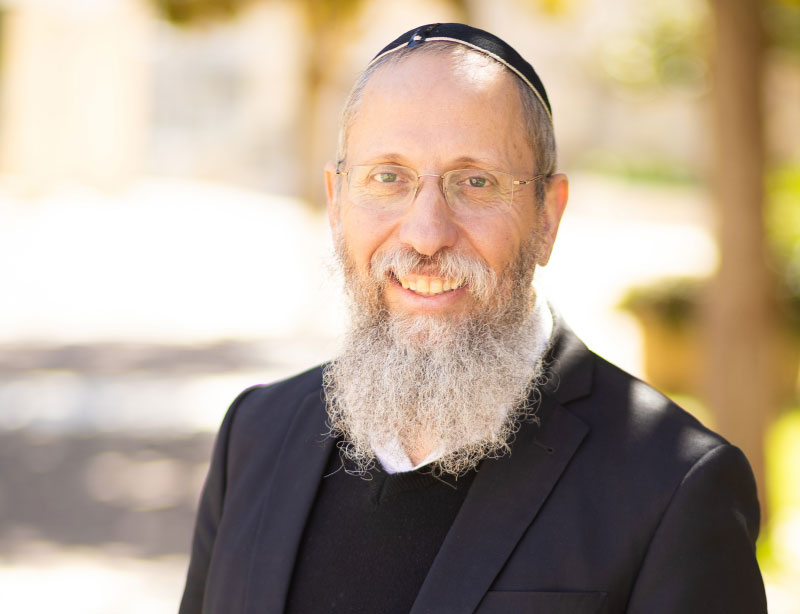May 30, 2022|כ"ט אייר ה' אלפים תשפ"ב Bechukosai 5782 - Our Greatest Bracha is the Ability to Appreciate the Brachos in Our Lives
Print ArticleOften, when we read Parshas Bechukosai, we focus on the terrifying tochacha, rebuke, that is promised if we don’t follow the way of HKBH. However, we should not overlook some of the beautiful brachos that are promised to us in this parsha when we do the right thing.
One of those brachos is found right at the beginning of the parsha. We are told that “Im Bechkosai Teleichu”, if we follow Hashem’s mitzvos and lead a way of life about which He can be proud:
(י) וַאֲכַלְתֶּם יָשָׁן נוֹשָׁן וְיָשָׁן מִפְּנֵי חָדָשׁ תּוֹצִיאוּ:
You shall eat old grain long stored, and you shall have to clear out the old to make room for the new.
And many of the commentators are confused by why the Torah emphasizes this detail as a bracha.
1) After all, is eating OLD grain really to be seen as a blessing?
2) Furthermore, don’t we always clear out old grain to make room for the new?
And this complication with this bracha leads to a number of different explanations.
Rashi writes that the bracha is that even the YASHAN, the old grain will be preserved so well that we will continue to have FRESH, AS NEW produce. And not only that, but there will such an abundance of FRESH, LIKE-NEW produce that when the new crop is ready to be brought into the storehouses, we will have to remove the old to make room for the new.
Following up on Rashi, Rav Shimshon Raphael Hirsch argues that this pasuk has to be understood in context. After all, the pasuk just before this one promises that one of the brachos is that Am Yisrael will have many children and continue to multiply. And, of course, the concern is that as the population grows our resources will not be able to keep up. Says the Torah, not so. If you are living life the right way, then not only will your families, communities, and nation grow, but the economy will be able to keep us as well.
According to Rashi & Rav Hirsch, the BRACHA of the YASHAN, the Old, is that it isn’t really old at all. The Old will remain NEW!
Faced with the same challenges as Rashi and Rav Hirsch, the Kli Yakar takes an entirely different approach. He argues that this pasuk is not meant to be taken literally, but rather metaphorically, and also must be appreciated in context. The pasuk immediately preceding this one ends: “V’Hakimosi Es Brisi Itchem” I will uphold My covenant with you”. And explains the Kli Yakar, the language of Yashan and Chadash is not only relevant to produce, but also to bris, to the covenants HKBH made with Am Yisrael.
We have a bris, known as the Bris Bein HaBesarim, but that is our “old” covenant in a sense. Because the Navi Yirmiyahu often talks about a Bris Chadasha, the new covenant that will be created in the times of Mashiach.
Yirmiyahu himself writes in the name of Hashem:
ולא יאמרו עוד חי ה' אשר העלה מארץ מצרים, כי אם חי ה' אשר העלה ואשר הביא מכל הארצות.
You will no longer refer to Hashem who took us out of Egypt, but rather Hashem who brought us back from other lands and gathered us back to Eretz Yisrael.
In that sense, argues the Kli Yakar, the promise Hashem is making is, “V’Achaltem Yashan Noshan” You will enjoy the current, original covenant, but at some point, “V’Yashan Mipnei Chadash Totziu” at some point the old covenant will replaced by the new one, in the times of Mashiach.
According to the Kli Yakar, the bracha is not about Old or New grain. It is about the bracha of knowing that HKBH will continue to maintain his YASHAN, ORIGINAL covenant with us, and then to be able to look forward to the name of the CHADASH, of the new Covenant B’Yimos HaMashiach.
Rabbi Bernard Weinberger, in his sefer, Shemen HaTov, offers a different approach to our question.
Our question was, how is it a bracha to tell me that if we listen to HKBH, V’Achaltem Yashan Noshan, we’re going to eat OLD produce?
Rav Weinberger notes that this pasuk alludes to a vital component of bracha that Hashem can offer us.
Continuing to make use of produce that was harvested years earlier reflects not only an overabundance of food, but also a much more challenging accomplishment: A change of attitude.
Study after study have shown the impact novelty has on the brain, allowing for the release of dopamine, and a short-term high every time we experience something novel. All of this leads to the tendency for all human beings to retract from that which is old and to be pulled towards that which is new – even when we don’t necessarily NEED it. Researchers have note that this is why when we feel sad, many people go shopping.
So, Hashem could keep the old grain fresh and usable for years, but that’s only half the bracha. The real bracha isn’t that we will HAVE MORE, it is that we will learn to APPRECIATE that which we have.
And this explanation actually fits beautifully with the text itself: The pasuk says, “V’Achaltem Yashan Noshan” You will eat the OLD grain which was stored for a long time”. Until now we have seen the bracha as the fact that they would have grain that lasts a long time. According to the Shemen HaTov, the emphasis is not on YASHAN, but on V’ACHALTEM. Not that the grain lasts, but that you’ll be willing to eat it! Because it is our ability to APPRECIATE the brachos in our lives which is the ULTIMATE BRACHA.
At a symposium on the topic of happiness run by Moment Magazine, Dr. David Pelcovitz wrote the following:
The English word “happiness” is related to the prefix of words like “happenstance,” “hapless” and “haphazard,” which implies that happiness is tied to chance: If you’re lucky enough to have the right kind of life or the right kind of possessions, you’re more likely to be happy. In fact, if you ask a group of Americans, “What do you think is most likely to make you more happy?” the number one answer is “more money.”
The corresponding Hebrew word for happiness is simcha, whose meaning people find by putting together the words sham [there] and moach [head] or “where your head is at.” It is tied to purpose and meaning. The founder of Hasidism, the Baal Shem Tov, encapsulated the cognitive element of well-being in his statement, “If you want to know where the essence of a person is, look at his or her thoughts”. Sham Moach.
With this explanation, V’Achaltem yashan noshan is not only ONE OF the brachos, it is the foundation on which all of the brachos stand. Because it is only when we have the ability to feel content with that which we have, that there can even be blessing, because it is only then that we will ever feel truly blessed.
And if this is all true, perhaps it also sheds new light on how leading a Torah life can lead to brachos.
Is Hashem promising us certain physical rewards if we follow His mitzvos? Yes, of course He is.
But perhaps He is also showing us that the greatest brachos that come from a Torah life are NOT the rewards He sends to us from on high, but the midos, the character development the Torah affords us if we are willing to find it for ourselves.




